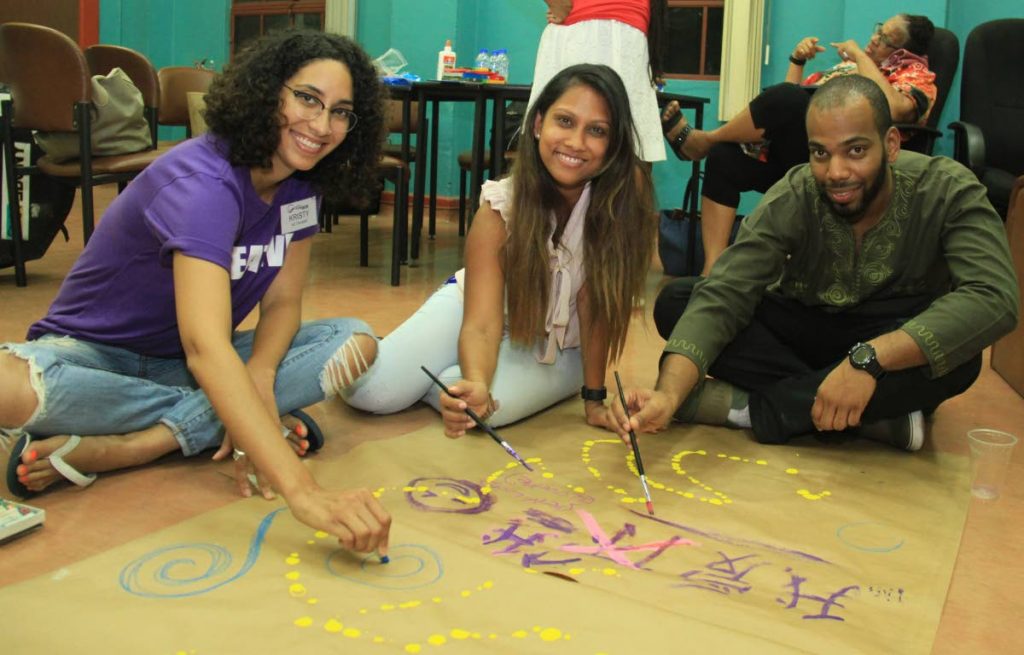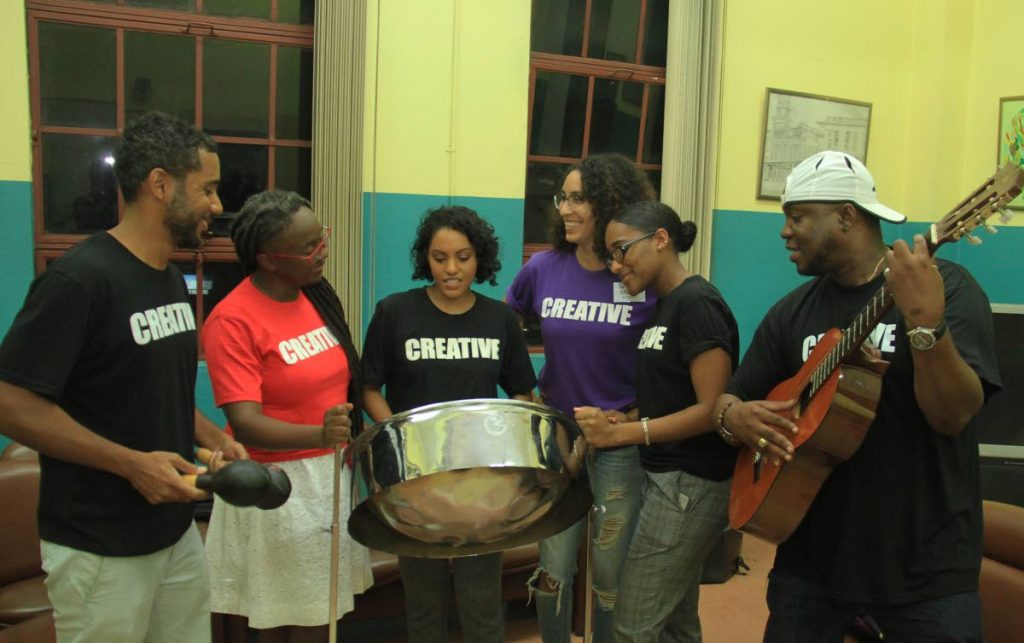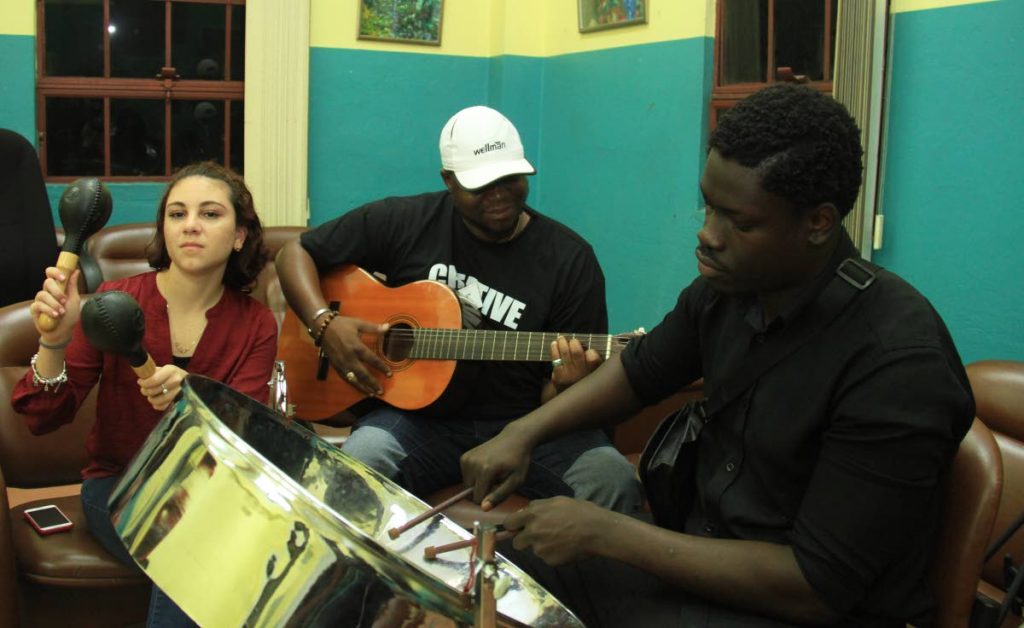Creative art therapy to express the things you just can't say

What happens when you don't have the words to express how you feel? What happens if a child does not yet have the vocabulary to say what is going on with him or her? What if a person struggles with non-verbal communication? How would they be able to access a psychologist if they need it?
This is where creative art therapy comes in.
In mid-March a collective of creative art therapists – comprising art therapists, music therapists, drama therapists and dance movement therapists – gathered at Queen's Royal College, Maraval Road, Port of Spain to host the second annual Creative Arts Therapies Week, put on by the collective to raise awareness of the different types of therapies available.
President of the Art Therapy Association Kristi Anatol said the art is another means of communication.

"A lot of times, depending on the person, you may not be able to verbalise what is happening. For instance, (for) children who don't know how to express their emotions, or children on the autism spectrum who are non-verbal, or even adults who are really closed off and they don't know how to speak about their emotions, the art is another means of communication, a means of expression, and you would be able to say the things that you would not be able to say with words.
"The art therapist is trained to pick up on certain symbols in the art and bring forth what would be happening subconsciously and have those conversations with the client."
The goal of Creative Art Therapy Week, Anatol said, was to raise awareness of creative art therapies in the country, an option many do not know exist.
"We wanted to raise awareness that these things exist and give people the chance to experience the modalities. We just wanted people to come and engage in the arts. All of the workshops were based on self-care, burnout, stress and how to cope with these things."
Anatol said the festival was also to destigmatise therapy as something that is needed for those with severe mental illness problems.
"People are still afraid to say, 'I want to see a therapist.'
"That does not mean something is wrong with you. Everyone can benefit from support. Sometimes I would see kids and I would recommend to parents that they should get their own support because you are bringing your child and trying to do everything for your child and you are probably stressed out, you have your own history, people don't realise you need the extra support until you are in it.
"There is a lot of awareness, education, trying to break that stigma, but people are afraid to go to a clinic because people see them and think something is wrong with them."

Anatol said one of the major misconceptions about art therapy is that the therapist can derive meaning from a client's art. In fact, it's the relationship the therapist has with the client that will allow them to understand the meaning of the art.
"It is always important to get meaning from the client. Ask them what they drew, how they felt and what kind of emotion they were trying to express.
"It varies from client to client. In thinking about how it works, you will still have therapeutic goals. The art is another means of communication to see information that might be below the surface. Subconscious things might be repressed. When a person has a history of trauma it might not be easy to talk about, sometimes in the artwork you might see certain themes coming out which might be easy to access."
The festival had a number of workshops that integrated different ways to deal with various topics. Clay in support of self-regulation was one of the workshops which engaged in kinaesthetic interaction and was led by art therapist Camille Bartholomew. Kinaesthetic interaction is the body's ability to feel and sense its own movements. This workshop used the clay as a way for the body to become aware of its sense, such as touch and the linking emotions attached to those actions. This workshop showed how working with clay and allowing the body to be mindful and feel its emotions can help in de-stressing.
"We are
talking about self-care, self-soothing and mindfulness...when you are creating with the clay you are in the here and now. So you are getting really engrossed in what you are doing...
"The idea is that your mind is not away from what you are doing, and that is soothing. Your mind is not racing, and the texture is soothing. When you think about making art you are taken back to when you are younger, when you were a child, and that in itself can bring those feelings of happiness and connected to the arts as well," Anatol said.
Other workshops in the festival included Redemption Songs: unpacking stories of resilience in everyday life. This was a drama therapy treatment by Karline Brathwaite.
Caregivers Need Care Too, led by Martina Chow-Antoine, was a music therapy workshop with healthcare professionals, parents, caretakers of elderly parents. This workshop looked at the need for caregivers to practice self-care using music therapy.
Of Queens and Crowns: exploring survival through found objects and therapeutic story making was an all-female drama therapy work led by Dr Tracie Rogers.
Though Anatol said the festival was a success, with many people showing interest, she lamented that there are very few creative art therapists in the country: 15 art therapists, two music therapists, three drama therapists and one dance movement therapists.
Because people aren't aware of art therapy, there are also few jobs in the public sector available. Both the music therapists work in St Ann's Psychiatric Hospital.
Anatol works between her own private practice and a few NGOs such as the Coalition Against Domestic Violence.
"People don't know about it, so there aren't really jobs out there. Even on the scholarship list, there are high-priority and low-priority jobs, and creative art therapy is saturated, meaning it is not needed, so it isn't something that is considered needed," Anatol said.
But she believes there is more need than ever for art therapists.
In schools, she said, "There are students who are acting out in class and 'I don't know what to do with these kids.' Then you sit down and make art with them – they are actually talking and expressing themselves. Instead of trying that one modality and saying it is not working, there are so many things you could try. But it is not being considered important."
For those who would like to contact a creative art therapist, here is a list of therapists at the Creative Arts Therapy Festival's Facebook page.


Comments
"Creative art therapy to express the things you just can’t say"